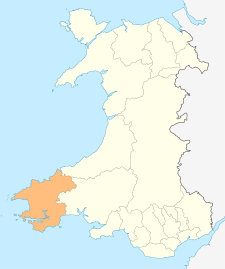Penally
Penally (Welsh: Penalun) is a coastal village, parish and community 1 mile (1.6 km) southwest of Tenby in Pembrokeshire, Wales. The village is known for its Celtic Cross, Penally Abbey (a Gothic style country house), the neighbouring St. Deiniol's Well, WWI Practice trenches,[2] and Penally Training Camp (World War I and World War II). In the community, though nearer to St Florence than Penally, is Carswell Medieval House, a Grade II* listed building.[3]
Penally
| |
|---|---|
 Penally Location within Pembrokeshire | |
| Population | 848 (2011)[1] |
| OS grid reference | SS1170099221 |
| Principal area | |
| Ceremonial county | |
| Country | Wales |
| Sovereign state | United Kingdom |
| Post town | TENBY |
| Postcode district | SA70 |
| Police | Dyfed-Powys |
| Fire | Mid and West Wales |
| Ambulance | Welsh |
| UK Parliament | |
History
Archaeological investigations of nearby Hoyles Mouth Cave shows evidence of Paleolithic and Iron Age use.[4] Artifacts found there can be seen at Tenby Museum.
Trefloyne (formerly Trellwyn) is an ancient manor, the seat of the Bowen family, and marked as a separate parish on a 1578 map,[5] but little evidence of the original manor house remains; it was still standing at the beginning of the 19th century, but in ruins by the 1880s.[6]
The Black Rock Quarry, between Penally and Tenby, provided heavy industry in the area during the nineteenth century, particularly after the Pembroke to Tenby railway arrived in 1863. Twelve large limekilns were built on a branch line c.1865.[7] They are the largest surviving limekilns in Pembrokeshire.
After World War II heavy industry made way for tourism, with the Kiln Park camping and caravan resort being developed near the old quarry site.[7]
Governance
An electoral ward with the same name exists. This ward stretches towards Saundersfoot whilst avoiding Tenby. The total population of this ward at the 2011 census was 1,710.[8]
Amenities
The local parish church is dedicated to St Nicholas & St Teilo. It was originally called St Nicholas' but was changed at the end of the 19th century; it is suggested that Penally was the birthplace of St Teilo, a Christian leader in the 6th century.[9] The church houses the Penally Celtic cross[10] which was originally located in the graveyard but has since been restored and moved into the church. The village has two pubs, The Cross Inn and The Paddock, a small shop and bus service 349.
Views overlook Tenby, Caldey Island, Giltar Point, and Tenby Golf Course, which runs alongside Tenby South Beach to the south of the village. Waymarked public footpaths allow people to walk through the links to the beach and to Tenby. Another golf course lies inland, to the west of the village, at Trefloyne.
Railway
Penally railway station on the Pembroke Dock branch of the West Wales Line is operated by Transport for Wales Rail, who also manage the station. Trains stop here on request every two hours in each direction, westwards to Pembroke Dock and eastwards to Tenby, Whitland, Carmarthen and Swansea.
Military establishment
Just beyond the western edge of Penally village sits the Penally training camp. This is a Defence Training Establishment used by regular, reserve and cadet forces.
A small firing range owned by the Ministry of Defence is located adjacent to Giltar Point on the coast. The range, which was built in the middle of the 19th century, was used to train soldiers during World War I and World War II. When the firing range is being used, red flags are flown and there are sentries stationed at the two huts along the coastal perimeter line. If firing is taken from beyond the 100 meter firing points (which run adjacent to the pathway which runs from railway station towards the beach) then an additional sentry post at Penally station level crossing is manned. Additionally a small safety boat is positioned off the coast. Part of the Pembrokeshire Coast Path is diverted along the A4139 road when the firing range is in use. The firing range has its own byelaws, which are reproduced on signs around the firing range perimeter and must be obeyed. The remains of the World War I practice trenches may be found towards the east of Giltar Point along the Pembrokeshire Coast Path.[11]
Wildlife
In March 2014 flocks of twitchers came to see a great spotted cuckoo, a species last seen in the UK in 2009. The inexperienced migrant came to Wales instead of Spain.[12]
References
- "Community population 2011". Retrieved 20 April 2015.
- http://www.coflein.gov.uk/en/site/268143/details/penally-first-world-war-practice-trenches
- Cadw. "Carswell Mediaeval House (Grade II*) (6005)". National Historic Assets of Wales. Retrieved 31 August 2019.
- "Royal Commission on the Ancient and Historical Monuments of Wales (Coflein), 2008". Retrieved 11 May 2014.
- "Penbrok comitat". British Library. Retrieved 22 August 2019.
- "RCAHMW: Ruins of Trefloyne Manor". Retrieved 1 September 2019.
- Peter Borsay; John K. Walton, eds. (2011), Resorts and Ports: European Seaside Towns Since 1700, Channel View Publications, pp. 101–102, ISBN 978-1-84541-198-5 Retrieved 28 April 2019.
- "Ward population 2011". Retrieved 20 April 2015.
- "Royal Commission, 2008 - St Nicholas & St Teilo". Retrieved 11 May 2014.
- "Royal Commission, 2008 - Penally Celtic Cross". Retrieved 11 May 2014.
- "Royal Commission, 2008 - Penally First World War Practice Trenches". Retrieved 11 May 2014.
- "BBC twitchers". Retrieved 15 April 2015.
